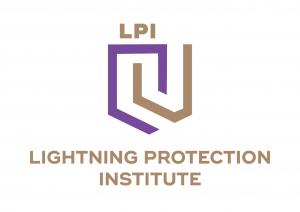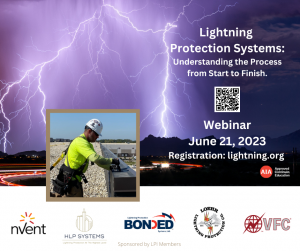The Lightning Protection Institute encourages people and businesses to “Be Prepared” and “Be Protected”
To support Lightning Safety Awareness Week, The LPI will host a webinar on the basics of lightning protection systems - June 21 at 11:30 AM.
Personal risks include burns to potential death. For homeowners and businesses, we may initially think of fires. The damage goes way beyond fires. One lightning strike can take out the electric system that controls business transactions, production lines, and communication systems. The ultimate impact is business interruption and loss of revenue while the repairs are completed.
We can mitigate these and other risks. Tim Harger, Executive Director of the Lightning Protection Institute (LPI) states “Proper assessment before a storm enables us to determine the best risk management strategies for ourselves, our businesses and communities.”
ASSESSMENT is the key to mitigating risks for people, homes, businesses and communities. The LPI encourages people to “be prepared” by assessing their risk of a lightning strike so they can protect themselves, their homes, businesses and communities. This assessment includes the evaluation of your situation before a storm.
For personal safety protocols, we recommend always checking weather BEFORE you leave for an event; check out our Tuesday social media post for more options. For business owners and the design/build community, an evaluation includes conducting the simple assessment which is included in the NFPA 780 standard. You can also ask yourself:
What will happen if this business or facility is NON-OPERATIONAL for a day…. or a week?
When it comes to insurance, The INSURANCE INFORMATION INSTITUTE, Triple I, uses a similar model of "Be Prepared. Be Protected." The Triple I encourages "Predict and Prevent." “Insurers are moving toward predicting and preventing losses by advocating for resilience in coordination with the real-time application of technology," stated Sean Kevelighan, CEO, Insurance Information Institute. "Lightning Safety Awareness Week highlights the dangers lightning poses to life and property and how insurers and policyholders are reducing these risks."
How do we make our homes and businesses RESILIENT to lightning?
Assessment can lead to the requirement of a lightning protection system, which is an action that can be taken before a storm to create resiliency. Lightning protection systems are scientifically proven to mitigate the risks of a lightning strike; certified installers and a 3rd party inspection (LPI-IP) will ensure the proper function of a system.
In our communities, we rely on critical facilities to provide services for our daily needs, as well as in a disaster. Critical facilities can include: fire stations, hospitals, police stations, governments facilities, emergency operation centers, and more. These critical facilities, in high-risk areas, should be protected by a lightning protection system to enable first responders to answer the calls of the community.
BE PREPARED. Assess your risk.
BE PROTECTED. Take the necessary actions to protect you, your home, your business, and your communities!
If you are in the design/build community or are interested in the basic understanding of lightning protection systems - the components and the process of installation - Come join us this Wednesday for a WEBINAR! AIA and IIBEC continuing education credits can be received for attending.
Lightning Protection Systems: Understanding the Process from Start to Finish.
Wednesday, June 21 at 11:30 AM.
WEBINAR Registration can be completed online at: https://lightning.org/technical/#webinars
Kelley Collins
Lightning Protection Institute
+1 800-488-6864
email us here
Visit us on social media:
Facebook
LinkedIn
Legal Disclaimer:
EIN Presswire provides this news content "as is" without warranty of any kind. We do not accept any responsibility or liability for the accuracy, content, images, videos, licenses, completeness, legality, or reliability of the information contained in this article. If you have any complaints or copyright issues related to this article, kindly contact the author above.


